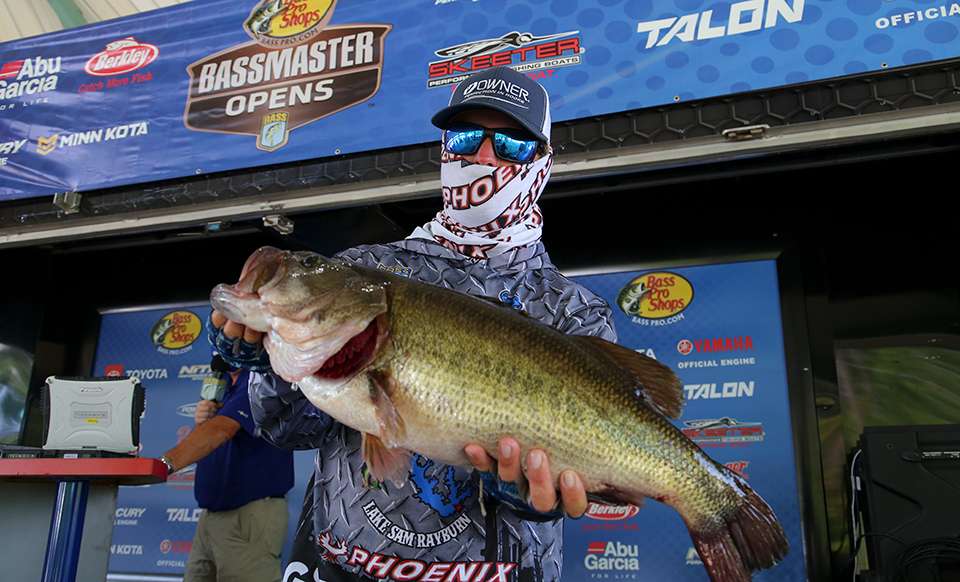
Everyone knows that September in the South often presents those tough days of lean opportunity that define the term “grind.” Anglers competing in the Basspro.com Bassmaster Central Open at Sam Rayburn Reservoir are seeing this firsthand, as the massive Angelina River impoundment is not making it easy on anyone.
“It’s still Rayburn,” many say. That means big fish — really big fish — live here, so any cast could fool a day-maker. With Shaine Campbell’s 9-pound, 6-ouncer leading the Phoenix Boats Big Bass contest among pros and William Young’s 9-0 leading the co-anglers, along with several 7- to 8-pounders, Rayburn is showing off its goods.
So, any cast? Yes, but not every cast. Not even close. We’re talking hours between good ones.
When it’s on
The bottom line coming down to one simple, yet elusive, truth: Summer bass have “bite windows,” often brief, intense periods when they decide to gobble a few shad or gulp a big bream.
Unlike spawning season, when loads of big fish move into predictable and easily accessible areas, this time of year finds bass scattered all over the lake. Also, the spring months typically find fish more aggressive and ready to bite. Be it pre or postspawn feeding needs, or territorial instincts common to the bedding period, spring finds bass in a more cooperative mood.
Not so this time of year. In fact, we heard several anglers stating that they found only a handful of quality bites. Among them, Dakota Ebare sacked up 20-12 but had his catch disqualified after self-reporting a rules violation. He lamented an early flight, which forced him to wrap up not long after things started clicking for him.
“It’s all about timing right now and being in the right areas at the right time,” said Ebare, whose catch included an 8-8. “If you get in those areas at the right time and they want to eat, it can be really good really quick.
“That one big bite goes a long way and there’s going to be a lot of people that do catch one big fish that carries them throughout the event. The most important thing is being able to stay consistent. Right now, the fish are moving a lot and it’s hard to do that.”
Key factors
As Ebare pointed out, photo period (daylight) always plays a big role in bass behavior; but so does water movement.
“We had (Hurricane Laura) recently, so they’re drawing a lot of current through the lake to power Jasper, Texas,” he said. “When they start running those generators and start generating current, the fish start biting.
“Also, in the afternoon, we started getting wind current, so you get all those that make the fish bite better. Day 1 was pretty tough from about 11-2, but I felt they were really starting to bite when I had to come in.”
In second place, Brian Schott’s 27-2 placed him only 8 ounces behind Day-1 leader Matsushita Masayuki. He was adamant about the need to run-and-gun, rotate through 50 different spots and do his best to dial in those bite windows.
“There are a lot of big bites to be had out there, but when it’s tough like this and the water temperatures are (high), it’s all timing,” Schott said. “The reason I’m fishing the way I’m fishing is not to go on a spot and sit there and wait for them to bite.
“I’m pulling up, looking for fish and going on if I don’t see much. You could be on the right spot at the wrong time and you’re just not going to get bit.”
Masayuki noted that sky conditions seemed to play a key role in his success. He fared best under the morning clouds, but said he struggled once the skies turned sunny.
Today’s forecast calls for at least partly cloudy skies through check-in time. This, coupled with some good water movement and afternoon wind could ignite this lake’s incredible potential.
Many variables
Realistically, the notion of specific bite windows is a moving target. Weather forecasts paint the meteorological picture, while publicly accessible power generation schedules tell us when to expect current increases. But within all this exists a myriad of micro-scenarios, each with their own localized details.
Is a bass holding in deep grass or wood — two distinct habitats with different forage, different shadow patterns, different degrees of temperature and oxygen content. Does one area have more sediment than another; in which case, increasing current varies turbidity levels.
When a bass wants to eat, the fish is gonna eat. However, two hungry bass 100 yards apart may feel the same influences, but exhibit different responses based on their specific habitat.
Bite windows happen, but a bass may or may not utilize the entire period of feeding stimulus. If that sounds challenging, it is. And that’s why you’ll often see many anglers experiencing one solid-to-great day but pairing it with a mediocre showing.
Consistency. Sometimes, it feels like a game of Whack-A-Mole. You swing and swing and swing and the more you miss, the more determined you get. But every now and then, you crack that varmint dead on his noggin, and it feels really good.
Kind of like making cast number 583 and feeling that thump.
Exasperation can mess with your head, but a steady, disciplined approach makes all the difference.
The ones that make it to Saturday’s final round will be the ones who hit the right spots at the right time for two days. Most will admit that whether they do it through a deeply analytical process or dumb luck — they’ll take it.

